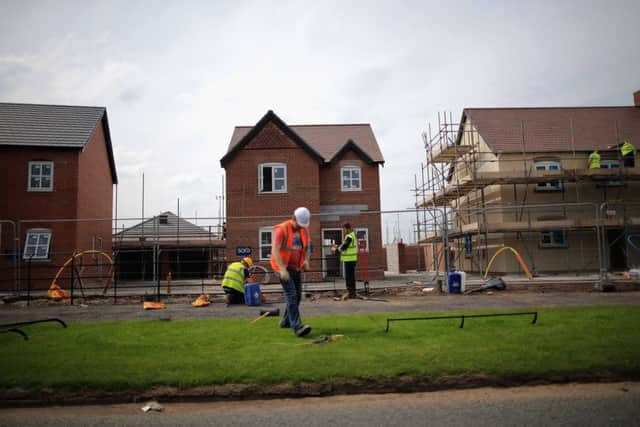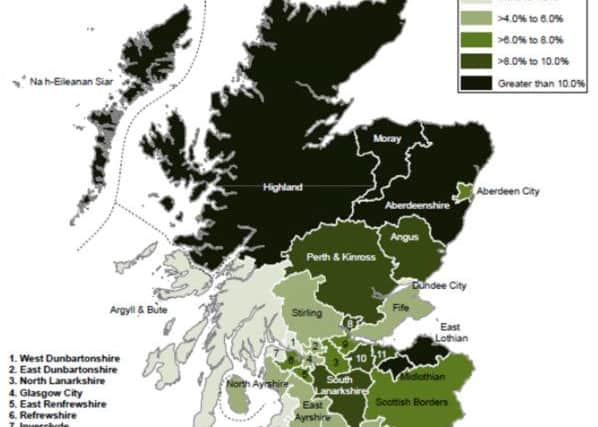Map: Across Scotland household numbers grow


The rise in the number of people living alone and overall population growth – particularly among the older generation – has helped to drive the number of occupied households around the country.
The Highlands and Islands have recorded some of the biggest proportionate rises in household numbers between 2005 and 2015, according to National Records of Scotland, with Edinburgh witnessing the largest increase in real terms.
Advertisement
Hide AdAdvertisement
Hide AdOrkney recorded a 13.6 per cent rise in households during the decade – the highest rate in the country.


While the rise is partly due to the number of single older people, the islands have experienced increased net migration in recent years due to quality of life and employment opportunities, such as the Flotta oil terminal and the European Marine Energy Centre at Stromness.
Currently, there is more demand for one-bedroom properties on Orkney than any other kind of accommodation, a spokesman for Orkney Isles council said.
Convener Steven Heddle added: “Our islands regularly top quality of life surveys looking at the best places to live in Scotland.


“A number of factors contribute to this and help explain why our population – and the number of households – are rising. We have a wonderful environment, high levels of employment, a low crime rate – and even our rainfall is below the Scottish average.
“The people who live here combine a strong and traditional sense of community with a forward-thinking, self-reliant, ambitious, can-do attitude that makes this a very special place to live and work.”
The number of households in Orkney is projected to grow by 17 per cent in the 25 years to 2037, a separate report by Audit Scotland found in 2014.
Around a quarter of households will be lived in by the over 75s by that time – around double the current rate.
Advertisement
Hide AdAdvertisement
Hide AdPlanning future services and maintaining communities on Orkney face a “major challenge” due to population changes and household growth, Audit Scotland found.
The Highlands also witnessed a significant growth in household numbers, with 12,042 more homes created between 2005 and 2015 – and increase of 12.7 per cent.
Inverness, the Inner Moray Firth, Badenoch and Strathspey and the Isle of Skye have seen the largest growth, a spokeswoman for Highland Council said.
Stuart Black, Highland Council’s director of planning, development and infrastructure, said the Highland economy had grown just behind Aberdeenshire’s in recent times.
He added: “We have benefited from a more diverse economy with strong performance in the energy sector – renewables and until recently oil and gas, tourism and the construction sector which has been supported by public investment with major projects like new schools across the Highlands and the Inverness campus.
“This will continue with investment in projects like the A9 dualling and the ongoing roll-out of superfast broadband.”
Aberdeenshire had the third highest rate of household growth over the decade at 12.5 per cent, with the rise largely due to the oil and gas boom but also driven by the availability of land.
The market town of Inverurie has witnesses the largest growth, with more than 1,100 homes built over the past decade, with Portlethen (885), Peterhead (818) and Westhill (822) also significantly expanding.
Advertisement
Hide AdAdvertisement
Hide AdEdinburgh has seen the largest increase in real terms, with 18,283 more households recorded in 2015 than in 2005 – an increase of 8.6 per cent.
Dundee was the only council area in Scotland where the number of households fell between 2014 and 2015, with 76 fewer homes recorded, National Records of Scotland (NRS) said.
NRS said the reduction was mainly down to the demolition of unoccupied properties.
Overall. Scotland had 2,557,582 dwellings and 2,433,956 households – dwellings which are occupied – by the end of 2015.
The Commission on Housing and Wellbeing recommended last year that the Scottish Government should build at least 23,000 homes a year until 2020 to keep up with population growth and housing standards.
